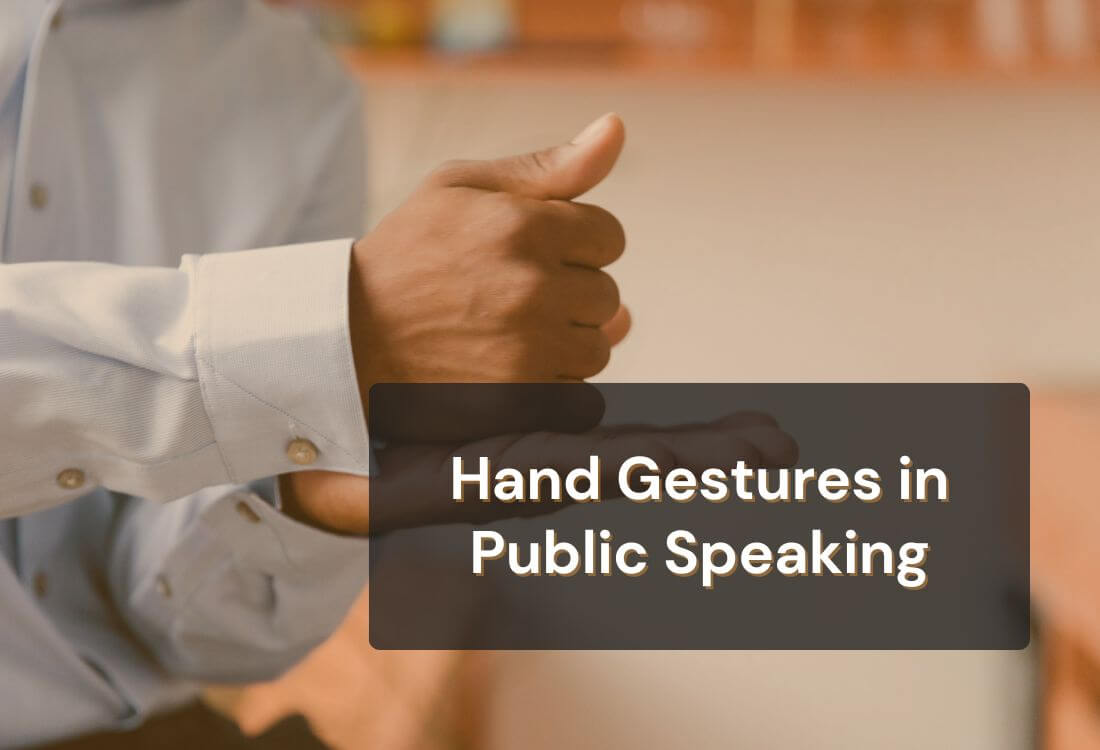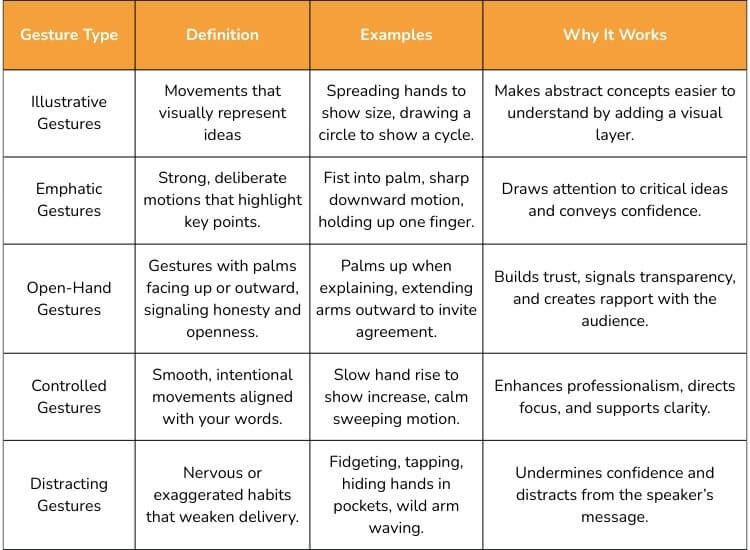



TL;DR: Hand gestures in public speaking can make or break your delivery. The right gestures emphasize key points, build trust, and keep your audience engaged, while the wrong ones distract or even offend. This guide covers the types of gestures that work, how to use them effectively, the mistakes to avoid, and cultural considerations every speaker should know.
Hand gestures in public speaking can be as powerful as your words. Audiences often pay attention to your voice and how you move your hands, which can determine how confident and convincing you appear. According to research on nonverbal communication, up to 55 percent of the impression you make comes from body language, with gestures playing a central role.
Using your hands with intention strengthens your stage presence, builds trust, and keeps listeners engaged. In this guide, we will explore how to use hand gestures effectively, the types that work best, and the mistakes to avoid so you can deliver presentations with clarity and impact.

Hand movements are essential in public speaking, as they enhance nonverbal communication, reinforce verbal language, and strengthen audience connection. Speakers can appear confident, emphasize key points, and build trust with listeners through effective gestures, whereas poor or distracting gestures will decrease clarity and credibility.
Research consistently shows that communication is far more than words. Albert Mehrabian’s widely cited 7-38-55 rule suggests that only 7 percent of meaning comes from words, 38 percent from tone of voice, and 55 percent from body language. Hand gestures form a large part of this nonverbal element, shaping how audiences interpret your message.
Gestures also activate the listener’s visual memory, making information easier to process and recall. A clear example is how presenters who “paint pictures” with their hands often seem more dynamic and memorable compared to those who keep their arms stiff at their sides.
The moment you step on stage, your body language sets the tone. Open-hand gestures, such as palms facing up, signal honesty and approachability. On the other hand, crossed arms or pointing too aggressively can create distance or even discomfort among listeners.
As visual guides, gestures are essential for public speakers who want to convey their message. Key points are highlighted by speakers through the intentional pairing of gestures, resulting in memorable impressions that cannot be captured by words alone.
The main types of hand gestures in public speaking are illustrative gestures, emphatic gestures, open-hand gestures, and controlled gestures. Each type serves a different purpose, from clarifying ideas to emphasizing points or signaling openness. Choosing the right gestures enhances clarity and audience engagement.
Movements that visually represent what you are saying, helping the audience picture your ideas.
Examples:
Benefit:
They make abstract concepts easier to grasp, especially when explaining numbers, comparisons, or timelines.
Strong, deliberate motions used to highlight or stress specific words or ideas.
Examples:
Benefit: These gestures add weight to key moments in a presentation, drawing the audience’s attention exactly where you want it. They also project conviction and confidence.
Gestures with palms facing upward or outward, signaling openness, honesty, and inclusiveness.
Examples:
Benefit: Open-hand gestures are universally seen as welcoming and trustworthy. They help break down barriers and create a sense of approachability, which is crucial for building rapport.
The difference between purposeful, aligned gestures and movements that distract from your message.
Benefit: Controlled gestures enhance clarity and professionalism, while distracting gestures can undermine confidence and credibility.

To use hand gestures in public speaking effectively, keep movements purposeful, match them with your message, and practice until they feel natural. Rehearsing with a teleprompter or camera can help refine gestures, while being mindful of cultural differences ensures your message is received positively.
Hand gestures to avoid in public speaking include repetitive or stiff movements, nervous fidgeting, overly aggressive pointing, and distracting habits such as hiding hands in pockets or touching your face. These gestures can weaken credibility and reduce audience focus.
Tip for Speakers: The goal is not to eliminate movement but to choose gestures that look natural and purposeful. A few well-timed motions are far more powerful than constant or distracting ones.

Offensive hand gestures in public speaking can unintentionally insult or alienate your audience, especially in multicultural settings. Even simple gestures may carry different meanings depending on cultural context.
You can train yourself to use better hand gestures in public speaking by practicing in front of a mirror or camera, rehearsing with a teleprompter, studying skilled speakers, and gradually integrating gestures into your delivery until they feel natural.

Hand gestures enhance audience engagement by emphasizing storytelling, sustaining energy, and guiding focus. When paired with eye contact and vocal variety, gestures make presentations more memorable and persuasive.
Hand gestures in public speaking are essential for delivering presentations that feel confident, engaging, and memorable. Purposeful movements combined with steady practice help eliminate distracting habits and allow your body language to align with your message. Using your hands with intention turns them into a natural extension of your voice.
Gestures act as powerful communication tools that shape how audiences perceive both your credibility and your clarity. From illustrative motions that bring ideas to life to open-hand gestures that foster trust, every movement has the potential to reinforce your words. With consistent practice and self-awareness, you can refine your gestures to enhance stage presence and deliver speeches that leave a lasting impact.
Ready to refine both your delivery and your stage presence? Sign up and explore Teleprompter.com to rehearse scripts, synchronize gestures, and speak with confidence.
The best gestures are the ones that feel natural and support your message. Open palms, illustrative movements like showing size or direction, and emphatic motions to stress key points all work well. The key is to keep them smooth and purposeful.
Gestures give your audience something to see as well as hear. They reinforce what you’re saying, make your ideas easier to follow, and help you appear more confident and trustworthy on stage.
Absolutely. Practicing ensures gestures don’t feel stiff or forced. Try rehearsing in front of a mirror, recording yourself, or even using a teleprompter app so your gestures naturally align with your words.
Yes, when gestures are overdone or repetitive, they can pull attention away from your message. Aim for variety but always tie your movements back to what you’re saying.
They definitely are. In fact, since body language is limited on video, visible hand gestures help you come across as more engaging and authentic. Just make sure they stay within the camera frame.



